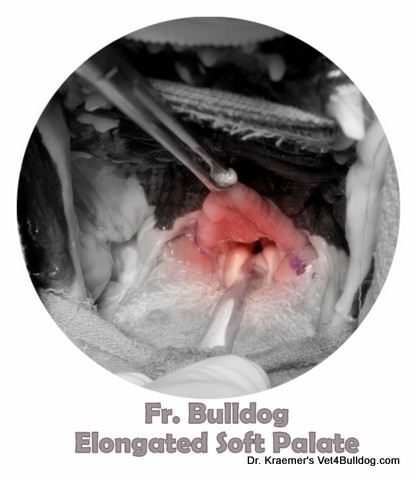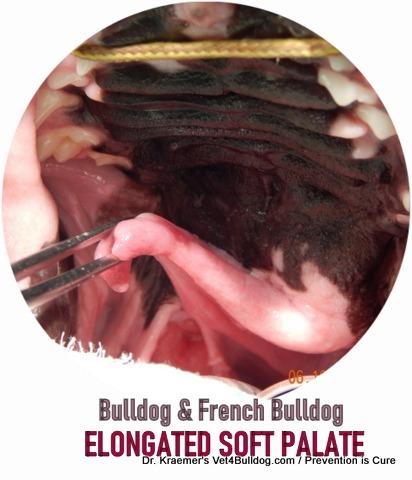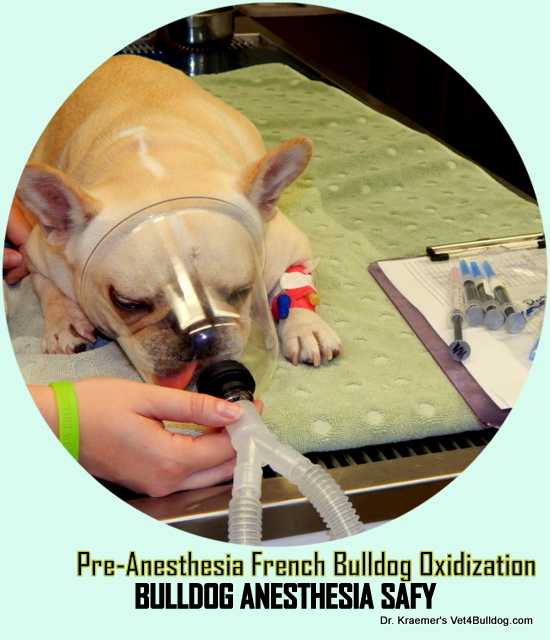Is Elongated Soft-Palate Laser Surgery Better?
Charlie my 3-year-old Frenchie needs pharyngoscopic surgery.
The vet that diagnosed it was going to do laser surgery. I was just informed the laser was out of service. I went to another surgeon who would do the procedure without a laser.

Which Surgery is Best For French Bulldog Elongated Soft Palate
As I read about the surgery, should I find another doctor who will use the laser?

Cost is not the issue I want what's best for my dog; should I wait? or get it done sooner as opposed to later?
My dog is miserable. She can't sleep, she can't play she gets anxious and scared when she has an episode
Please help me make the best choice for my Frenchie Charli
Is Laser Better Than Cut-And-Suture For Soft Palate Surgery?
In the realm of surgeries, various options often present themselves, each with its merits, making the selection of the "gold standard" seem overwhelming.
Laser Versa Cut-and-Suture Surgery for Bulldog Soft Palate
While I’ll explore the pros and cons of each surgical approach, it’s important to emphasize that the specific technique should not be your main concern.
What truly matters is choosing a skilled veterinarian with extensive experience in diagnosing and treating brachycephalic obstructive airway syndrome (BOAS.)
Regardless of the method they prefer, expertise with the condition, and especially with brachycephalic breeds—is what ensures the best outcome for your dog.

Laser Vs. Cut and Suture Palate Surgery: Merits and Drawbacks
Common points of comparison include:
- Speed: Which method is faster?
- Bleeding: Which one causes less bleeding?
- Cost: Which one is more expensive?
- Infection: Which one carries a higher risk for infection?
- Post Operatively:
- Swelling: Which one causes more post-op swelling?
- Thermal Burn: Which one results in more thermal burn damage?
- Scar: Which one leads to more post-op scarring?
- Healing Time: Which one takes longer to heal?
- Improvement: Which one yields a better all-around outcome?
The emphasis should be placed on the surgeon's experience and expertise rather than the specific technique used.
Elongate Palate Surgery Duration and Safety:
Experience more than technique choice translates to a shorter surgical time and optimal outcomes.
Elongate Palate Surgery Bleeding, Swelling, and Infection:
Regardless of the chosen technique (laser or traditional), a meticulous, sterile approach ensures a smooth and successful surgery for your bulldog.
Elongate Palate Surgery Success Rate:
The consistent success rate in any surgical procedure relies heavily on the experience and expertise of the surgical team
- Skills: Superior skills and efficiency.
- Technique: The meticulous technique ensures a smooth recovery for your bulldog.
- Hygiene: Focus on hygiene and sterile procedures minimizes infection risk.
Optimal Outcome: Surgeon's track record and consistently positive outcomes.
SURGEON TRACK RECORD RULE OF THUMB
- Has performed a high volume of similar surgeries.
- Has a proven track record of success.
- Prioritizes minimizing pain and recovery time.
- Is experienced in managing potential complications.
Is Laser Better For Soft Palate Surgery? QUESTIONS TO ASK:
Here are the important inquiries you want to make:
#1 SURGEON'S EXPERIENCE:
What is the extent of the surgeon's expertise with BOAS and brachycephalic breeds?
When it comes to bulldogs and other flat-faced breeds, general surgical experience isn't enough. The surgeon should have a proven track record of diagnosing and treating brachycephalic obstructive airway syndrome (BOAS), with specific knowledge of the breed’s unique anatomy and challenges.
#2 SURGEON'S SKILLS & TECHNIQE:
How proficient is the surgeon in performing their chosen surgical method for this condition?
While there are various surgical techniques for treating BOAS, the most important factor is how skilled the surgeon is in the method they use. Consistency, confidence, and successful outcomes with that technique are more important than the specific approach itself.
#3 ANESTHESIA & RECOVERY EXPERTISE:
How experienced is the surgical team in managing anesthesia and postoperative recovery in bulldogs?
Brachycephalic breeds are at higher risk during anesthesia. A well-trained team familiar with bulldog-specific airway concerns, preoperative screening, anesthesia protocols, and post-op care is critical for a safe and smooth recovery.

Is Laser Better For Soft Palate Surgery? SUMMARY
Laser: If your surgeon is highly skilled and experienced with laser surgery, that method is likely the best choice.
Cut & Suture: On the other hand, if they are more proficient with traditional cutting and suturing techniques, it’s preferable they use the approach they know best.
The surgeon’s comfort and expertise with their chosen method will have a greater impact on the outcome than the technique itself.
Most surgical procedures offer multiple technique options, each with its own set of advantages and considerations.
Ultimately, the most important factors influencing the choice of method are the
- surgeon’s skill and experience with the breed
- Surgeons familiarity and confidence with the chosen technique
- Expertise of the supporting surgical and anesthesia team. A well-executed procedure by an experienced team will always outweigh the theoretical pros and cons of any specific approach.
My Soft Palate Surgery Preferences:
Over two decades ago, as I was establishing my bulldog-focused practice, I discussed the debate between laser and traditional cut-and-suture soft palate surgery with a highly respected, board-certified surgeon.
His response left a lasting impression: he favored the traditional cut-and-suture technique, citing less post-operative scarring as a key benefit. That perspective strongly influenced my early surgical preferences.
Since then, my practice has evolved alongside technology. While I’ve embraced tools like the laser, my focus remains on long-term outcomes and patient-specific results—not the tools themselves.
The technique that offers the best prognosis for the individual dog, regardless of whether it involves a scalpel or a beam of ligh, is the one I recommend.
Both laser and cut-and-suture approaches come with advantages and trade-offs. The key is thoughtful case selection, guided by the surgeon’s experience, the dog’s specific anatomy and condition, and a deep understanding of bulldog airway disease.
It’s not about the method—it’s about doing what’s best for your patient.
SURGEON PREFERENCE TIPS & WARNINGS:
Surgeon Biases: The substantial financial investment involved in acquiring surgical equipment—such as “hot lasers”—can inadvertently influence decision-making within veterinary clinics and among individual surgeons.
- Naturally, there is a desire to justify and recover that expense, which may lead to the laser being favored as the default surgical tool, even in cases where other methods might be equally effective or more appropriate.
- This dynamic can unintentionally introduce bias, reinforcing the perception that laser surgery produces superior outcomes, even when clinical evidence is mixed or inconclusive.
- Furthermore, the more frequently a surgeon uses a particular device, the more skilled and comfortable they become with it, naturally reinforcing it as their preferred method. Over time, this familiarity can further entrench their confidence in that technique, regardless of whether it is objectively superior in every case.
As with any medical decision, it’s essential that the chosen technique be guided by patient-specific needs and sound clinical judgment, not equipment economics.
 HOT LASER vs. COLD LASER
HOT LASER vs. COLD LASER
The terms "cold laser" and "hot laser" are often used to describe different types of lasers based on their applications and the effects they produce.
I use a class 4 cold laser post-operatively to reduce swelling and stimulate healing.
Here are the key differences:
Cold Laser (Low-Level Laser Therapy, - LLLT):
These are designed to stimulate cellular function and promote healing without generating significant heat.
Cold lasers are primarily used to
- stimulate cellular processes
- reduce inflammation
- accelerate tissue repair
They are commonly used in physical therapy, sports medicine, and wound healing.

Hot Laser (High-Level Laser Therapy, HLLT):
These are designed for
- cutting
- coagulation
- tissue ablation.
These lasers produce more heat and can be used for surgical and therapeutic purposes.
Hot lasers are employed in surgical procedures such as laser eye surgery, dermatological procedures, and various soft tissue surgeries.
It is not typically used for non-invasive therapeutic purposes.
Hot Laser vs. Cold Laser SAFETY:
The main difference lies in the intended use and the thermal effects produced by the lasers.
Cold lasers focus on non-invasive therapeutic applications with minimal heat, while hot lasers are designed for surgical and tissue-altering procedures, producing significant heat as part of their mechanism.
COLD LASER HIGH SAFETY:
A cold laser is non-invasive and generally considered safe. It does not cause thermal damage to tissues and is well-tolerated by patients.

HOT LASER SAFETY:
Hot lasers being used in surgical and invasive procedures carry inherent risks associated with tissue heating and ablative effects. Proper safety precautions are crucial in its application.
Hot laser proper safety precautions are crucial in its application.
I trust that I have provided clarity and assisted you in your decision-making process.
Kind regards,
Dr. Kraemer, Vet4Bulldog
Recommended by Owners Approved by Bulldogs











